|
- Catalog (in stock)
- Back-Catalog
- Mail Order
- Online Order
- Sounds
- Instruments
- Projects
- History Face
- ten years 87-97
- Review Face
- our friends
- Albis Face
- Albis - Photos
- Albis Work
- Links
- Home
- Contact
- Profil YouTube
- Overton Network
P & C December 1998
- Face Music / Albi
- last update 03-2016
|
1. Ay, da ne iz tuchuski veterochki duyut - historical song - 4:30
2. Ot pletnyovikh ot vorot - dance song - 2:45
3. Ali vy, kubantsy - historical song - 4:03
4. Ay chego zh ty pochernelo, zelenoe pole - historical song - 4:09
5. Oy, naplyvaly ya chorny khmary - humorous song - 2:43
6. Proshchay ty, Uman'skaya stanitsa - lyrical song - 2:55
7. Da v sadu derevo tsvetyot - campaign song - 2:36
8. Poekhal kazak na chushbinu - lyrical song - 4:39
9. Vospoil voskormil ya kundyubochku svoyu - dance song - 1:57
10. Ay, polno, brattsy, nam krushit'sya - lyrical song - 3:45
11. U vorot sosna zelenaya - dance song - 2:29
12. Tucha s gromom pogremela - historical song - 2:58
13. Vy, katachki-kazaki - dance song - 2:35
14. Prosnyotsya den' krasy moyey - lyrical song - 3:47
15. Po luzhochku zelyonomu - lyrical song - 4:06
16. Oy da zapryagu ya troyku borzykh - lyrical song - 4:07
17. Ay, golub', ty moy golubok - lyrical song - 3:10
18. Pora molodtsu zhenit'sya - dance song - 2:05
19. Chorny voron - historical song - 4:55
20. Oy ty yablon'ka - dance song - 2:11
21. Khodil brodil nash Dobrynyushka - byline (epic hero song) - 2:27
22. Oy ty zayushka - dance song - 2:44
|
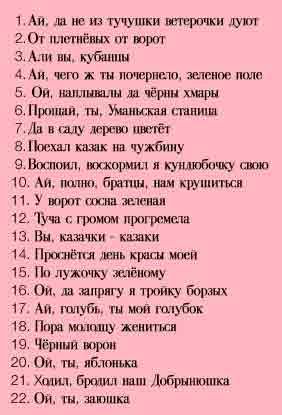 |
The Ensemble Pesnokhorki (formed by: pesnya - song and khorki - choir) was founded in 1979 by Olga A. Abramova.
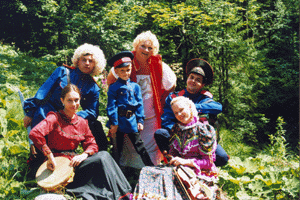
Irina, Dmitri, Dani, Olga, Elena and Igor
- The Cossacks
The Cossackdom is one of the most original and significant appearances of Russian history. In the 16th century cossack communities developed in the southwest, southern and southeast, in the region of Moscow, in Belarus and the Ukraine. They accomplished a great deal for the Russian with the colonization of conquered territories and the defense of same. They also influenced the state's interior law-and-order and the historical evaluation of the country.
More information on cossacks please find in the first two records of the Ensemble Pesnokhorki - Vol. I, FM 50017 and Vol. II, FM 50019, published by Face Music as well as in the record of the Ukrainian Ensemble Khreshchaty Yar - Vol. I, FM 50031.
- map sketch Host of Cossacks
- The Don Cossacks
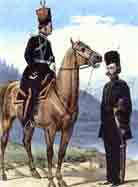 |
In the second half of the 18th century, there was established a first community at the river Don. At the same time, a very similar community, the Zaporoshyeskaya setch, was built in the Ukrainian steppe.
The structure of these cossack communities was the same everywhere. Land was common property, and real estates were not owned privately, there was also full equality for all members of the community, and the community elected an administration for a certain period of time, which was accountable to the community itself. The community was entitled to determine its administration before the end of the fixed period of time and decide on new elections.
In contrast to the Zaporoshyeskaya setch, they lived in families in Don communities in their settlements or towns situated at the river Don and its tributaries Medveditsa, Khoper, Donets and Sherebets. In the middle of the 17th century, about 30 such settlements had been developed.
Apart from military campaigns, the cossacks lived on fishing and hunting. Corn they got from the government in exchange for services rendered, and partly also from the settlers in neighbouring areas, with whom they exchanged fish and als Turkish and Tatarian goods. Only the administration of the army in the case of military campaigns was held by a cossak leader (the ataman), who was elected by the cossack assembly ("Krug", Russian for "the circle"). His assistant was called 'yessaul", "cossack captain", and an army secretary was responsible for the correspondence. These people were also appointed by the united cossack assembly.
|
At first, Werkhnije Rasdory served as headquarters for the cossacks, later on the settlement Tsherkassk, which had been foundet by those fled from the Ukraine and territories under the rule of the Tsar, was chosen as new headquarters. Also a lot of people from the Ukraine and the territories under the rule of the Tsar settled at the river Don. The more power the cossacks gained, the stronger and harsher their invasions into Turkish or Tatarian territories became. The Turkish Sultan asked the Moscow Tsar to put an end to these raids. His answere to this plead, however, was that these people were not citizens of his state but rather escaped convicts who were not supported by anybody. Nevertheless, the Russian government still maintained relations with the cossacks and secretly provided them with goods like corn, arms and salpeter. Attempts made by the Moscow government under Tsar Fédor I. (1584-1598) to act as mediator between cossacks and the population from Azov failed. In the times of turmoil, the Don Cossacks actively participated in the rather frequent revolts and supported all Usur Tatars. Revolts at the river Don only came to an end with the election of Tsar Mihail I. (1613-1645). Since the year 1623 the Don Cossacks were under the rule of the Office of Foreign Affairs, and they were provided with yearly amounts of money, corn, cloth, arms and munition by order of the Tsar. This provision did not prevent the cossacks from pursuing their own policy, rather independent from Moscow, from organising military raids across the Black Sea, from robbing and devastating the Crimean and Turkish fringe territories. After numerous complaints and warnings uttered by the Turkish Sultans and the Crimean Khans, Tsar Mihail I. sent the Don Cossacks a writing of disfavour in 1630, which also included a religious ban for the Don Cossack army signed by the patriarch. This was the first time that the relation between the Don Cossacks and the government under the Tsar broke off.
For two years there was no relation between the Don Cossacks and the Moscow government. This was, however, renewed by Tsar Mihail I. in the year 1633, as he needed this army for his projected military campaign to Poland. The Tsar forgave the cossacks and invited them to serve the state. After numerous battles against the Nogais, the Crimean and the Tatars from Azov as well as the Turks, the cossacks finally decided to gain free access to the sea. In the year 1637 they took the region Azov by storm, and in 1641 they freed the town from suppression by the Turkish army, which tried in vain to reconquer the town by means of siege. After this challenge, the cossack army was totally exhausted and asked the government in Moscow to integrate Azov into the federation of stately ruled counties. A corporative assembly convoked by the Tsar decided against a war with the Turks. The state of Moscow was too weak and poor. The cossacks were given the order to withdraw from Azov. The empty town again was taken under siege by the Turks who took advantage of the cossacks' lack of power and destroyed their settlements Manytsh, Yar, Tsherkassk and pushed them back to Werkhnije Rasdory. Shortly after, the cossacks reconquered their settlements burnt to ashes. In the year 1647 the Azov, Crimean, Nogais and Tsherkess Tatars attempted to reconquer these settlements by means of long-term siege. The cossack army got weaker and weaker, and it became necessary to ask the Tsar for help. He sent Strelitse and free men to the river Don. Hence it was not possible for the Turks to extinguish the cossacks with fire and sword. But they wanted to obstruct their access to the sea; for this reason, they built towers at both banks of the river Don in order to restrict access by means of chains. An attempt made by reinforcements from Moscow to conquer these towers failed. The cossacks, therefore, built a channel, the so-called "Yerik", by means of which they had access to the open sea with their ships and thus were able to again rob Turkish ships and settlements.
- 8. Poekhal kazak na chushbinu - The cossack rode with his faithful horse away
Lyrical song of the Don-Cossacks of the stanitsa Zimnyatski, Rayon Serafimovichski, area of Volgograd.
- Igor Sazontov: tenor (lead singer), Elena Sazontova: alt, Dmitri Olkhovski: bass, Irina Borodina: sopran (high register)
The cossack rode with his faithful horse away and left his young wife with his parents at home. She looks out of the window every morning and evening and waits for him to return home. A little bird tells her what has happened to him far away and where his bones are buried under the snow.
- 9. Vospoil voskormil ya kundyubochku svoyu - I gave food and beverages to my love
Dance song of the Don-Cossacks of the stanitsa Nigniy Erohin, Rayon Kamenski, area of Volgograd.
- Igor Sazontov: tenor (lead singerr), bayan (accordion), Elena Sazontova: alt, Dmitri Olkhovski: bass, spoons, Irina Borodina: sopran (high register)
I gave food and beverages to my love, and I want to marry her. But because of evil people I could not do so. Stay all alone and on your own, my love, as I will come to you when the green grass is high.
- 10. Ay, polno, brattsy, nam krushit'sya - Let us stop being sad and worried
Lyrical song of the Don-Cossacks of the stanitsa Ust-Buzulukskaya, Rayon Alexeyevski, area of Volgograd.
- Igor Sazontov: tenor (lead singer), Elena Sazontova: alt, Dmitri Olkhovski: bass, Irina Borodina: sopran (high register)
Brother, let us stop being sad and worried. Let us talk and sing a song on our cossack life based on our pain and sorrow. Our life is bad, good, however, is our fame.
- 11. U vorot sosna zelenaya - At the gate, there is a green pine tree
Dance song of the Don-Cossacks of the stanitsa Zimnyatski, Rayon Serafimovichski, area of Volgograd.
- Igor Sazontov: tenor (lead singer), bayan (accordion), Elena Sazontova: alt, Dmitri Olkhovski: bass, Irina Borodina: sopran (high register)
At the gate, there is a green pine tree, in the house, there is a young woman. She sieves the flour, will bake bread and send it to Wankjka, a young man in the village behind the river.
- 12. Tucha s gromom pogremela - There has been rain and thunder
Historical song of the Don-Cossacks about the Tsar Nikolaj II of the stanitsa Kumilgenskaya, area of Volgograd.
- Igor Sazontov: tenor (lead singer), Elena Sazontova: alt, Dmitri Olkhovski: bass, Irina Borodina: sopran (high register)
There has been rain and thunder for three days. The great Tsar Nikolaj is a good warrior; his chest is decorated with orders. He has come to praise his faithful cossacks, "his children", to award them orders and say good-bye to them.
- 13. Vy, katachki-kazaki - You, cossacks are military people
Dance song of the Don-Cossacks.
- Igor Sazontov: tenor (lead singer), bayan (accordion), Elena Sazontova: alt, Dmitri Olkhovski: bass, Irina Borodina: sopran (high register)
You cossacks are military people, nobody loves you.
Once a Polish woman loved a cossack. She took him by the hand, led him into the house, kissed him and called him "my dear". She wanted to teach him French. And in return he should teach her Russian, she wanted to know how to say, "Give me some money" in Russian.
- 14. Prosnyotsya den' krasy moyey - The day of beauty awakes
Lyrical song of the Don-Cossacks of the stanitsa Ust-Buzulukskaya, Rayon Alexeyevski, area of Volgograd (after motifs of a poem by Lord Byron).
- Igor Sazontov: tenor (lead singer), Elena Sazontova: alt, Dmitri Olkhovski: bass, Irina Borodina: sopran (high register)
The day of beauty awakes. I can see the sea and the sky, but this is not my home. I have left my parents' home. My heart longs for home, but I will never return. It is my fate to be in a country I was not born in but rather in a country where I will be punished and get my sentece.
- 15. Po luzhochku zelyonomu - A beautiful woman walked across green grass
Lyrical song of the Don-Cossacks of the stanitsa Yaminski, Rayon Alexeyevski, area of Volgograd.
- Igor Sazontov: tenor (lead singer), Elena Sazontova: alt, Dmitri Olkhovski: bass, Irina Borodina: sopran (high register)
A beautiful woman walked across green grass. She went for a walk, she stomped onto yellow sand.
- 16. Oy da zapryagu ya troyku borzykh - I harness my trojka
Lyrical song of the Don-Cossacks.
- Igor Sazontov: tenor (lead singer), bayan (accordion), Elena Sazontova: alt, Dmitri Olkhovski: bass, Irina Borodina: sopran (high register)
I harness my trojka and take a ride in a cold night to visit my love. My horses know the way; the coachman sings a song, buys red wine. Do not waste the golden days of your life; there are not that many! As long as my curls still exist, I will love youn women.
- 17. Ay golub', ty moy golubok - Aj, my dove
Lyrical song of the Don-Cossacks of the stanitsa Ust-Buzulukskaya, Rayon Alexeyevski, area of Volgograd.
- Igor Sazontov: tenor (lead singer), Elena Sazontova: alt, Dmitri Olkhovski: bass - Irina Borodina: sopran (high register)
My dove, you have got beautiful wings. My dove, why do you not visit me? Don’t you know the way?
- 18. Pora molodtsu zhenit'sya - It is time for a young man to get married
Dance song of the Don-Cossacks.
- Igor Sazontov: tenor (lead singer), bayan (accordion), Elena Sazontova: alt, Dmitri Olkhovski: bass, Irina Borodina: sopran (high register)
It is time for a young man to get married and leave the house. Open the gate! Take care that the horses are harnessed and that the coach waits in front of the gate! My love is on the way, on the way to Moscow, on the way to foreign countries.
- 19. Chorny voron - Black bird, how far have you travelled?
Historical song of the Don-Cossacks.
- Igor Sazontov: tenor (lead singer), Elena Sazontova: sopran (high register), Dmitri Olkhovski: bass, Irina Borodina: alt
Black bird, how far have you travelled? From where did you bring the white hand with this ring? I have recognised my friend by this ring. So he died in the war and is buried far away.
Then there came a good man and buried 240 people; and he put up a wooden cross saying, "Here are buried the heroes of the Don? Long live the Don Cossacks!"
- 20. Oy ty yablon'ka - Oh, my apple tree
Dance song of the Don-Cossacks.
- Igor Sazontov: tenor, bayan (accordion), svirel (reed pipe), Elena Sazontova: alt (lead singer), Dmitri Olkhovski: bass, Irina Borodina: sopran (high register)
Oh, my apple tree, did you give birth to two apples? Two garden apples like honey? They run across the garden, drink a lot of juice, and disappear like sugar.
- 21. Khodil brodil nash Dobrynyushka - Our Dobrynjushka went for a walk
Byline (epic hero song) of the Don-Cossacks of the stanitsa Yaminski, Rayon Alexeyevski, area of Volgograd.
- Igor Sazontov: tenor (lead singer), Elena Sazontova: alt, Dmitri Olkhovski: bass, Irina Borodina: sopran (high register)
Our Dobrjnyushka went for a walk, over steep mountains, across wild steppes. For him, however, there are only three ways: to Muron, to Moscow and to Kiev.
- 22. Oy ty zayushka - Where are you, bunny
Dance song of the Don-Cossacks.
- Igor Sazontov: tenor (lead singer), gùsli (wood zither), svirel (reed pipe), Elena Sazontova: alt, violin, Dmitri Olkhovski: bass, Irina Borodina: sopran (high register), kugikly (tubular wood block)
Where are you, bunny. You have been away since yesterday evening; you have been gone during the night and not come back this morning.
- The Zaporosh'ye Cossacks
The Ukrainian Cossacks who had been under permanent pressure by the Polish government began to revolt more and more actively, and with the support of the subjugated peasants, they won the fight. Moreover, they separated the originally Russian territories from Poland, and most of the population there joined the cossack community.
In regard of the Ukrainian farmers who did not belong to Poland anymore but also did not have an opportunity to get the independancy of their home country accepted, they were forced to surrender to the Russian Tsar and became his subjects.
Reforms accomplished at the end of the 18th century led to the destruction of all Ukrainian Cossack communities on the left shore, and also the Zaporoshye Cossacks were not spared. The Don and the Yaik Cossacks were reorganised. The Caucasian Cossacks succeeded in preserving their individuality and their priviliged status a little longer.
- 5. Oy naplyvaly ya chorny khmary - The sky fills with dark clouds
Humorous song of Zaporoshye Cossacks, area of Krasnodar.
- Igor Sazontov: tenor (lead singer), bayan (accordion), svirel (reed pipe), Elena Sazontova: alt, violin, Dmitri Olkhovski: bass, Irina Borodina: sopran (high register)
The sky fills with dark clouds, it starts to rain. Poor cossacks, you visit a low dive and drink vodka. You talk, get drunk and worry about life. Those who do not understand the way of life these poor people lead, are not welcome in the dive and hence thrown out.
- The Terek Cossacks
In the Caucasus, cossack communities with many small independent settlements were established, which were then divided into a few bigger units by the government.
The Greben army was the oldest of these communities. The Terek army was founded by people born at the mouth of the river Terek in the Volga in the 16th century, and in the beginning it was independent. But after the Tsarist generals had had the small town Terk built in 1586, the cossacks started to serve there and secure this settlement. The Terek Cossacks were primarily fishermen, which is the reason why they visited the Volga region rather frequently, even after the formation of the army. In this way, they participated in the turmoils at the beginning of the 17th century. Apart from those born in Russia, also the Caucasian population already settled there joined the cossacks, who from then on also started the settlement along the river Terek.
The Terek Cossacks were forced into a permanent war with their neighbours, mainly free living Kuban tribes who had tried to destroy the town of Terk in the 17th and beginning of the 18th century a couple of times. In 1722 Peter I. the Great (1682-1725) decided to advance the borderline of the Russian fortresses; therefore, he told the cossacks to withdraw from Terk and found a new fortified settlement at the river Sulak, a place where the tributaryr river Agrakhan has its mouth. The Terek Cossacks were re-settled into this fortified settlement, which was called "St. Cross fortress", and they were, for this very reason, renamed Agrakhan Cossacks. The unusual climate and the frequent attacks by Chechen and Dagestan people brought distaster on the army. In the year 1736, the territories won by Peter I. along the river Sulak and at the shore of the Caspian Sea had to be given back to Nadyr-Shah. The army then had to withdraw, and a new fortress was being built at the river Kislar. At this point of time, only a few 200 cossacks were on duty, whereas this army survived until the year 1832 under the name Terek-Kislar army. Afterwards it was assigned to the Caucasian Line Army.
In order to fortify the Terek army, in the year 1724 one thousand cossack families were resettled from the Don who first belonged to the Agrakhan army but later on moved to three little towns between the territories at the river Greben and the river Kislar, when they had left Agrakhan; from this time on, they have been called Terek Family Army. In 1832 they became part of the Caucasian Line Army.
- 1. Ay, da ne iz tuchushki veterochki duyut - This is not the howling of the wind
Historical song of the Terek Cossacks of the stanitsa Chervlenaya Shelkovskoi, area of Chechen.
- Igor Sazontov: tenor (lead singer), Elena Sazontova: alt, Irina Borodina: sopran (high register)
This is not the howling of the wind, it is not the noise made by oak trees, this is not cries uttered by birds – this is the lamenting of cossacks. They have lost the Tsar's mercy. The time has gone by when they were esteemed by the Tsar and recipients of many presents. Now, their leader Shamil has been arrested. He has to say good-bye to the mountains and his friends and is to face the Tsar's requital.
- 2. Ot pletnyovikh ot vorot - There is a path leading from the gate
Dance song of the Terek Cossacks area of Chechen.
- Igor Sazontov: tenor (lead singer), Elena Sazontova: alt, Dmitri Olkhovski: bass, Irina Borodina: sopran (high register)
There is a path leading from the gate to the lake from which the women carry home the water. Among them, there is also Tanjusha, Grishka's wife. He sits at home, looking out of the window and dreaming of having enough money. Then his wife would not have to work but would rather sit in the shade, play the fiddle, dance and entertain Grishka.
- 3. Ali vy, kubantsy - Oh, you Kuban Cossacks are real warriors
Historical song of the Terek Cossacks of the stanitsa Kubanskaya, area of Krasnodar.
- Igor Sazontov: tenor (lead singer), Elena Sazontova: alt, Dmitri Olkhovski: bass, Irina Borodina: sopran (high register)
Kuban cossacks are real warriors and also real humdingers. They have arrested Shamil, the leader. He has to say good-bye to the mountains and his friends and is to face the Tsar's requital. If the Tsar has mercy with him, he will stay happy. If not, he will be punished.
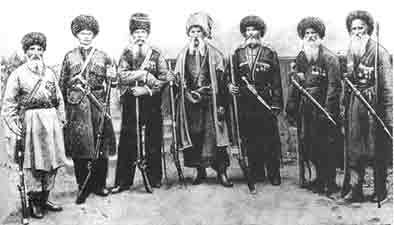
Terek-Kuban Cossacks – Russian-Turkish Campaign 1877-1878
- The Kuban Cossacks
The Old Believers (1) who had been pursued and expulsed after the council of 1667 moved to the territories along the river Don and there founded several retreats, especially at the river Medveditsa. The propaganda distributed by the Old Believers quickly spread and infiltrated a large majority of the cossacks led by the eldest Samojla Lavrentjev and Kirej Matvejev. Plans for a revolt were elaborated, but these plans, however, were met by strong resistance. In the year 1688, Moscow sent Tsarist troups in order to pass sentence on the Old Believers with the help of cossacks faithful to the Tsar. Hence their hope to remain in their home country vanished, and they moved to the river Kuma, and later on they decided to seek refuge with the Crimean Khans and moved to the river Kuban.
- (1) Old Believers: Under Tsar Alexei I. (1645-1676), the Quiet One, Patriarch Nikon (1605-1681) had tried to cleanse lithurgy from infiltrated discrepancies and to re-integrate rites of the Byzantine Church, which was met by strong resistance on the side of the Old Believers.
Soon after the extinction of the Zaporoshyeskaya setch, Prince Potemkin had the idea to re-organise this cossack army in order to enable securing the frontiers of the new Province of Novorossisk. In the year 1783, he allowed the former Zaporoshye Cossacks from Apron Golovatij, Chorek Tshepega and Legkostup to recruit volunteers for service in a cossack army. In 1787 Catherin II, the Great (1762-1796), who received deputies of the former Zaporoshye Cossacks from Krementshug, gave the permission to re-create the old army and call it the "Army of Faithful Cossacks". This reanimated army actively participated in the war against the Turkish. Tshepeg was nominated ataman of the army, whereas Prince Potemkin was military captain, as he had been ataman of the cossack armies of the Black Sea and the Ekaterinoslovsk since 1790. In 1788 Catherin II gave the territories at Kertch and Taman to the army, but in 1790, on suggestion by Potemkin, the territories between the rivers Dnjepr and Bug were given to the "Army of Faithful Cossacks" for settlement. Within two years 25 settlements were established by former Zaporoshye Cossacks. In 1792 the army was offered to move to the Kuban and settle at the lower course of this river. The cossacks founded the town Ekaterinodar (1794) and further 40 settlements on this territory. The army had to protect the border against permanent attacks by neighbouring mountain people. Due to this mass migration, more than 100,000 people from the Ukraine had moved to the Kuban region.
A conquest of the regions of Crimea and Kuban made under the reign of Catherin the Great was the reason why the state aimed at reanimating the cossack outposts for guard duty. In 1792 the Don Cossacks also moved to the territories at the Kuban at the new outer frontier.
- 4. Ay chego zh ty pochernelo, zelenoe pole - Why has the battleground turned black
Historical song of the Kuban Cossacks.
- Igor Sazontov: tenor (lead singer), Elena Sazontova: alt, Dmitri Olkhovski: bass, Irina Borodina: sopran (high register)
Why has the battleground turned black as if flooded with blood for freedom? No, it has turned black because of the ravens that sit on the dead corpses of brave warriors. So many have died in the battle that the ravens only pick their eyes.
- 6. Proshchay ty, Uman'skaya stanitsa - Good-bye, Umanskaya stanitsa
Lyrical song of the Kuban Cossacks of the stanitsa Leningradskaya, area of Krasnodar
- Igor Sazontov: tenor (lead singer), Elena Sazontova: alt, Dmitri Olkhovski: bass, Irina Borodina: sopran (high register)
The cossack goes to war. He says good-bye to his village, his wife, to everything he loves: the sun behind the mountains, the nightingale in the garden. His wife cannot sleep, she cries all night long.
- 7. Da v sadu derevo tsvetyot - A tree blossoms in the garden
Campaign song of the Kuban Cossacks
- Igor Sazontov: tenor (lead singer), Elena Sazontova: alt, Dmitri Olkhovski: bass, Irina Borodina: sopran (high register)
A tree blossoms in the garden, the cossack goes to war. Don't be sad, young woman, do not cry. It is not so bad.
- Instruments
|
- Kugikly - tubular wood block - reed pipe (wind instrument)
|
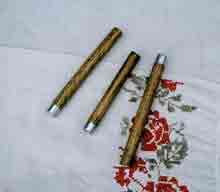
|
Kugikly are panpipes (used similar like the panpipe). They can have anywhere from 1 to 8 pipes, though 2-5 pipes glued together seems to be a common set. They seem to be most often played by groups of women.
Kouguikly autant d'onomatropees ..................................................
|
|
- Gùsli - wood zither - folk psaltery (string instrument)
|
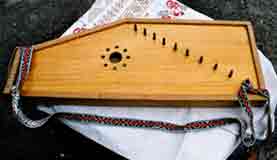
|
It's plucked rather than hammered. In that functional sence it has more relationship to a harp, or better yet a zither (or autoharp) than with a hammered dulcimer or cimbalom. The gùsli is most often played upright, with the edge of the long and down on the knees; the left hand (over the runing pins and bridge) damps the strings not in the chord / melody, while the right hand strums or plucks the strings.
The gùsli has approached a certain standardization (primo, alt or bass sizes). The diatonic tuning of the gùsli ranges from B below middle C to C# two octaves abouve middle C. The keys of A, Bm, C#m, D, E, F#m, and G#m are available. The tuning was standardized to optimize its use with the balalaika and dömbra. It is very difficult to use a gùsli so tuned with Russian folk wind instruments such as the zhalaika and rozhok; these instruments (especially the rozhok) are tuned in G and C. The solution has apparently been to add sharping levers. These are called mekhanik in Russian.
The gùsli is mentioned in the epic by the eleventh-centruy bards.
|
|
- Bayan - button accordion
|
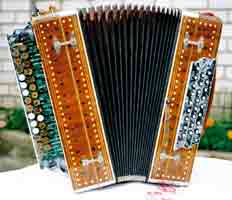
|
Originally, the bayan came from the Ukraine to Russia. Today it is very frequently played, and in the meantime has substituted many very traditional folk instruments. The button accordion initially came from Germany in the 1830ies to Russia.
With the button accordion all notes of the chromatic scale may be played, and the buttons are arranged in a way so that each key may be played without changing the chord. The plates or reeds, which are rather different in form and material, make different tones for a single note possible, and as it is the case with an organ, with the bayan it is also possible, due to a system of different registers, to distribute air in a way enabling variation of timbre. These registers are manipulated by means of sixteen keys situated above the right keyboard, and the register switches used most of the time may also be operated by the chin, by means of seven buttons situated on top of the instrument.
|
|
- Vladimir horn - Vladimirski Rozhok - horn trumpet (wind instrument)
|

|
This is a wooden horn with trumpet-style mouthpiece and finger holes. It has historically been most common in the northeast-central parts of European Russia near Vladimir (hence the name "Vladimir horn") and Varoslav.
The basic diatonic set of rozhki would include one or two sopranos in G, an alto in C, and a tenor (an octave below the soprano) in G. Besides the diatonic instruments, there are now chromatic rozhki. The rozhok can play its first octave in pure tones, then by overblowing you can go into further (higher) register. So, unlike the previous instruments, you get more than an octave.
|
|
- Svirel - reed pipe, pennywhistle (wind instrument)
|
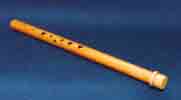
|
The group of flute-like reed wind instruments is known as svirel in the Russian language. The use of this denomination has led to great confusion as a distinction between the different types of folk wind instruments has been turned into a rather difficult challenge because of this. This is the result of the fact that the meaning of the word svirel, strictly speaking, only applies to a non-recorder.
The svirel do not have a mouthpiece. They consist of a hollow pipe with six up to ten holes. The pipe itself may be made of any kind of material, also metal and plastics. Usually the numer of holes is six, but additional holes make it possible that chromatic notes may be easily created with the instrument. The important difference lies in the end of the pipe where the player has to strike his/her breath against the tube wall. This creates a similar tone like that of the flute.
|
- More information: Traditional Music and Instruments of the Russian and Siberian people
English translation and revised by Hermelinde Steiner.
|
